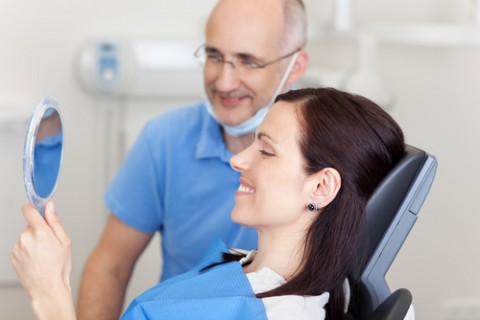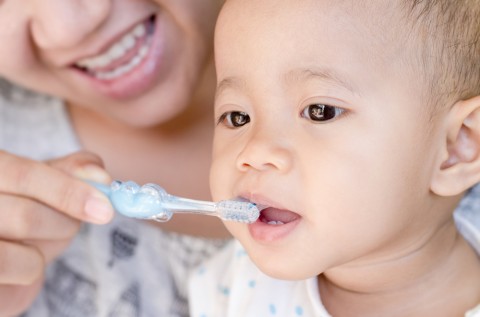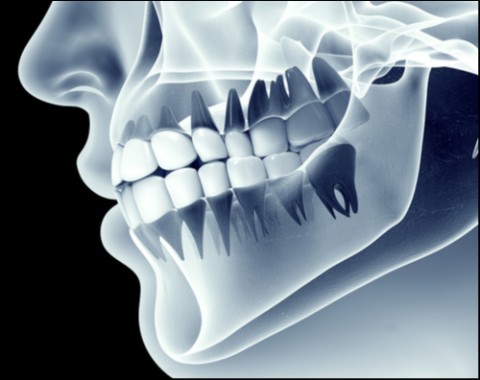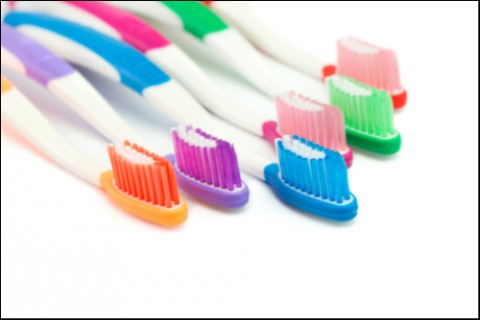 The benefits of exercise to the body are seemingly endless. From stronger muscles to lower body weight and decreased risk of diseases like diabetes, heart disease, cancer and stroke, the pluses of staying fit go way past just looking good. But did you know that one fitness plan in particular can help ward off the gum disease gingivitis? It’s called HIIT, and it could take a swing at this common early-stage gum disease.
The benefits of exercise to the body are seemingly endless. From stronger muscles to lower body weight and decreased risk of diseases like diabetes, heart disease, cancer and stroke, the pluses of staying fit go way past just looking good. But did you know that one fitness plan in particular can help ward off the gum disease gingivitis? It’s called HIIT, and it could take a swing at this common early-stage gum disease.
 Yo-yos, matchbox cars, dolls and tin robots - they’re all classic toys, but one of them could soon be changing the way we practice dentistry. Today’s robots do way more than the robot toys of yesteryear - today we use robots for everything from cleaning floors to diffusing bombs - but a new wave of robots could soon help care for your oral health.
Yo-yos, matchbox cars, dolls and tin robots - they’re all classic toys, but one of them could soon be changing the way we practice dentistry. Today’s robots do way more than the robot toys of yesteryear - today we use robots for everything from cleaning floors to diffusing bombs - but a new wave of robots could soon help care for your oral health.
 Made only in certain regions of Italy, prosecco is having its moment in the sun with wine enthusiasts lately. Made from at least 85 percent glera grapes, this versatile sparkling wine can be used for everything from pre-dinner aperitivo to celebratory dessert toasting and everything in between. Touted as the less expensive alternative to champagne, this delicious bubbly beverage may be causing an unexpected side effect to your teeth: enamel erosion.
Made only in certain regions of Italy, prosecco is having its moment in the sun with wine enthusiasts lately. Made from at least 85 percent glera grapes, this versatile sparkling wine can be used for everything from pre-dinner aperitivo to celebratory dessert toasting and everything in between. Touted as the less expensive alternative to champagne, this delicious bubbly beverage may be causing an unexpected side effect to your teeth: enamel erosion.
 In many cultures, a baby’s first tooth eruption is a celebrated milestone in their life. Here in the United States, there is usually even a line to mark the occasion in most baby books. But what happens after that first tooth appears can be a little confusing. For years, toothpaste manufacturers have marketed fluoride-free cleansing pastes and gels to help keep those early baby-teeth clean without running the risk of babies ingesting too much fluoride during brushing. But while fluoride-free toothpastes certainly help keep babies and children’s teeth clean, without added fluoride, children using these pastes are missing out on the added protection fluoridated toothpaste provides.
In many cultures, a baby’s first tooth eruption is a celebrated milestone in their life. Here in the United States, there is usually even a line to mark the occasion in most baby books. But what happens after that first tooth appears can be a little confusing. For years, toothpaste manufacturers have marketed fluoride-free cleansing pastes and gels to help keep those early baby-teeth clean without running the risk of babies ingesting too much fluoride during brushing. But while fluoride-free toothpastes certainly help keep babies and children’s teeth clean, without added fluoride, children using these pastes are missing out on the added protection fluoridated toothpaste provides.
 You may have heard the term "biomimetic" before, but what you may not know is how it relates to dentistry- or why we are so passionate about using a biomimetic dentistry approach with our patients. The word biomimetic literally means ‘imitating (mimesis) life (bios).’ In dentistry, biomimetic dentistry means we take a minimally invasive approach to dental care- an approach which strives to keep as much of the natural tooth intact as possible. We do this by using specialized techniques, tools, and advanced materials to repair damaged teeth- instead of just cutting away the damaged area and hoping whatever we stick to the tooth stays in place and looks realistic. The ultimate goal of our practice, and of biomimetic dentistry as a whole, is to "help our patients keep their teeth for a lifetime... In a condition that’s beautiful and that’s functional."
You may have heard the term "biomimetic" before, but what you may not know is how it relates to dentistry- or why we are so passionate about using a biomimetic dentistry approach with our patients. The word biomimetic literally means ‘imitating (mimesis) life (bios).’ In dentistry, biomimetic dentistry means we take a minimally invasive approach to dental care- an approach which strives to keep as much of the natural tooth intact as possible. We do this by using specialized techniques, tools, and advanced materials to repair damaged teeth- instead of just cutting away the damaged area and hoping whatever we stick to the tooth stays in place and looks realistic. The ultimate goal of our practice, and of biomimetic dentistry as a whole, is to "help our patients keep their teeth for a lifetime... In a condition that’s beautiful and that’s functional."
What makes biomimetic dentistry different is kind of like that old metaphor about optimism versus pessimism, where you are asked whether you see the glass half full or half empty. Traditional methods of dentistry historically have taken a more pessimistic approach, giving little thought to the remaining structure of the tooth, and instead focusing on the repaired section. When you pay more attention to the restoration, it’s a lot like seeing the glass as half empty, because you are not focused on the healthy portion of the tooth. With biomimetic dentistry, we aim to repair the damage to the tooth, not to simply replace the damaged areas, as this essentially creates more damage to the tooth in the process. This is like seeing the glass half-full because we understand the importance of preserving the natural tooth.
In addition to your teeth looking better with biomimetic dentistry, biomimetic dentistry offers two things that many traditional procedures cannot: comfort and predictability. Because biomimetic procedures are minimally invasive, they are naturally less painful than traditional dentistry procedures. Not only that, but most patients experience less tooth sensitivity after the procedure, as well. As for predictability, with biomimetic dentistry, there are no surprises. You already know what your tooth looks like, so restoring that tooth creates no change in the look or feel of your natural tooth. Best of all, because the tooth is repaired, you can feel confident that the health of your teeth is protected- and that you will keep your natural teeth for the rest of your life.
So, given what we know about biomimetic dentistry, why don’t more practices apply biomimetic dentistry principles to their practice? The biomimetic approach is not as easy as traditional dentistry. Biomimetic dentistry requires a lot of skill, patience, and training. It requires the dentist and their staff to look at dentistry under a completely different lens than they were probably initially trained to do. Hopefully, in the future, this will change, and biomimetic dentistry will someday become the standard of care in all practices. But until then, finding a practice which follows the principles of biomimetic care and maintains their focus on the health of the existing tooth instead of the damaged portions of the tooth can be an integral part of enjoying the strength and beauty of your natural teeth for the rest of your life.
If you’d like to learn more about how Dr. Lederman and the biomimetic approach to dentistry can benefit the holistic health of your teeth, give us a call at 516-882-1764 for an appointment.
 It’s no secret that pollution and environmental damage can have harmful effects on your health. You’ve probably seen news reports about how poor air quality can contribute to an increase in skin and lung cancers, among other things. But did you know that the environment can also be linked to chronic conditions like Temporomandibular Joint Dysfunction (TMJ) and sleep apnea? Dr. Gary Lederman discusses how something as simple as the air we breathe can have a huge impact on our bodies.
It’s no secret that pollution and environmental damage can have harmful effects on your health. You’ve probably seen news reports about how poor air quality can contribute to an increase in skin and lung cancers, among other things. But did you know that the environment can also be linked to chronic conditions like Temporomandibular Joint Dysfunction (TMJ) and sleep apnea? Dr. Gary Lederman discusses how something as simple as the air we breathe can have a huge impact on our bodies.
 If you’ve ever watched professional sports on TV, you’ve probably noticed athletes from a variety of different sports wearing mouth guards. But while mouthguards make sense in rougher sports like hockey, football, and boxing, did you know that athletes from every genre of sport can utilize the benefits of mouthguards? One such mouth guard- the Pure Power Mouthguard, is creating a lot of buzz in both the athletic and dental communities. We spoke to Dr. Gary Lederman of Bellmore, NY about this innovative technology.
If you’ve ever watched professional sports on TV, you’ve probably noticed athletes from a variety of different sports wearing mouth guards. But while mouthguards make sense in rougher sports like hockey, football, and boxing, did you know that athletes from every genre of sport can utilize the benefits of mouthguards? One such mouth guard- the Pure Power Mouthguard, is creating a lot of buzz in both the athletic and dental communities. We spoke to Dr. Gary Lederman of Bellmore, NY about this innovative technology.
Our bodies are complex systems that are interconnected in many ways. One part usually almost impacts another in some shape or form. Our mouths are no different, which is why the practice of neuromuscular dentistry can be quite beneficial, though it’s a fairly unknown form of dentistry. Dr. Lederman finds this type of dentistry has been the right fit for many of his patient’s suffering from mouth and jaw issues.
Many dental patients who wear dentures are not satisfied with the results because the shape and condition of their jaws can change due to bone loss and the loss or displacement of other teeth over time. But there is no excuse for tolerating the frustration of ill-fitting dentures. Dr. Gary Lederman is a dentist who specializes in helping patients with ill-fitting dentures upgrade to the new American Dental Association (ADA) standard of care – dental implants.
But dental implants are far more expensive than dentures, so aside from the fit, why upgrade? A dental patient wearing dentures –that fit well, mind you—exert approximately 50 psi of bite force, whereas dental implants can restore you to a full healthy bite force of 150 psi. This means that opting for dental implants can dramatically improve your quality of life by restoring your ability to indulge in more solid foods. Not only does this provide you with the ability to enjoy more foods and flavors; it allows you the opportunity to have better nutrition through food choices as well.
The other problem with dentures? When you lose an adult tooth, your tooth roots are not stimulated by the activity of chewing, and that lack of stimulation means that the root structure is no longer summoning the appropriate nutrients to maintain the place they occupy in your jaw, and your jaw actually begins to shrink through a process called osseointegation. The jawbone actually gets smaller to bring your remaining teeth closer together so that nature maintains your ability to chew with what you have left. This can result not only in functional degradation, but cosmetic deformation of your facial features as well.
When dental implants are placed, the oral surgeon inserts a titanium screw post into the jaw bone, and Dr. Lederman tops the post with a porcelain crown. The titanium posts embedded in the jaw actually fuse with the bone and prevent further bone loss. In fact, this fusion makes the dental implant and the the jawbone one, and maintains the full 150 psi bite force and the root stimulation for the areas the teeth have been lost.
To schedule a consultation to determine if dental implants are right for you, call our office at 516-882-1764.
For most people, going to the dentist is one of their least favorite things to do. In fact, that’s often why it gets pushed to the bottom of the priority list. But for some people, the anxiety they experience before and during a dental appointment can be debilitating and may even cause them to forgo dental treatment all together. Dr. Lederman wants his patient to have the most comfortable experience possible while undergoing dental treatments, which is why he offers sedation dentistry.
Sedation dentistry is a technique used to help patients relax during dental procedures or treatments. It helps ease anxiety associated with dental fear. Because stress can cause patients to become agitated and sometimes less cooperative, procedures can take longer to complete. When patients are in a more relaxed state, it helps expedite the process by eliminating resistance from the patient which in turn allows the dentist to work more quickly. Additionally, if more than one procedure is necessary, your dentist will be able to perform them in one sitting. Sedation dentistry allows patients to be more at ease, making the experience considerably more comfortable.
At our office, our sedation dentistry process doesn’t involve needles. We take a gentler and less invasive approach. Instead, patients take one pill approximately one hour before their visit. You aren’t unconscious but rather in a more relaxed state, making your appointment less stressful and much easier to manage.
If you’re nervous or anxious about your upcoming dental appointment, sedation dentistry might be right for you. Call our office today at 516-882-1764 to request sedation dentistry for you next appointment.
Often publications have shown how particular foods are bad for teeth because they introduce sugars and acids that promote the development of plaque and tooth decay. However, since 2005, researchers have been looking to cranberries and cranberry juice as a possible ally in the war on plaque, gum disease and tooth decay. Dr. Gary Lederman offers professional dental cleanings and restorations to help patients keep their smiles in tip top shape.
So what is magical about cranberries apart from other foods and juices that makes them good for your teeth? When eaten raw, the texture of the cranberry acts as a detergent food helping to brush sticky plaque forming bacteria away from teeth to be carried off by saliva as you chew. This property has also been found in apples, celery, and certain cheeses.
But what is most interesting about cranberries and sugarless cranberry juice is the way that researchers have found it inhibits the growth of oral biofilm containing the bacteria streptococcus mutans. Streptococcus mutans is the main ingredient in the formation of plaque. Additionally, chemicals in the cranberry juice also reduce inflammation and reduce the production of acids and restore the pH balance of the oral flora.
However, this does not mean that you should run straight to the grocery store and buy just any cranberry juice off the shelf. Most commercially produced cranberry juice is full of sugar and other additives that can cancel out the benefits of the cranberries. Scientists have been working since 2005 to find ways to isolate cranberry extracts for inclusion in tooth pastes and mouth wash.
To learn more or schedule your semiannual checkup, contact our office at 516-882-1764.
Dr. Lederman works to help his patients maintain their smile in some of the most minimally invasive ways possible. One such way is through biomimetic dentistry, a type of dentistry that promotes tooth conversation. One of the primary principles of biomimetic dentistry is maintaining and conserving natural tooth structure. By utilizing minimally invasive techniques that treat weak and decayed teeth, dentists are able to strengthen and seal effected teeth and preserve their natural integrity.
Biomimetic loosely translates to “mimicking nature.” The goal of this type of dentistry is to preserve as much of the natural tooth as possible. Oftentimes, traditional dentistry requires dentists to compromise the healthy tooth structure to successfully restore it. In contrast, biomimetic dentistry aims to minimize this by only replacing that part of the tooth that is damaged.
Once a tooth has been structurally compromised, such as being prepped for a crown, it often requires additional work which further chips away at the natural tooth. Ironically, while a crown is meant to protect and strengthen the tooth, it can have the opposite effect. For a tooth needing a crown, a biomimetic dentistry approach only removes the damaged part of the tooth. The final restoration, often called an inlay or onlay, is safely bonded to the natural tooth. In fact, using a biomimetic approach can actually preserve a tooth that might otherwise require extraction.
Biomimetic dentistry is a great way to preserve the appearance of your smile while also maintaining the look, structure and strength of your natural tooth. Contact our office at 516-882-1764 to learn more.
 The holiday season is fast approaching, and so are a thousand photo ops with friends and family. Is your mouth ready for its close up? Dr. Gary Lederman’s got some great tips for making your smile outshine the lights of the season- and for keeping it bright during all those parties.
The holiday season is fast approaching, and so are a thousand photo ops with friends and family. Is your mouth ready for its close up? Dr. Gary Lederman’s got some great tips for making your smile outshine the lights of the season- and for keeping it bright during all those parties.
 Soft bristle, hard bristle, small, medium, large, electric, manual- these are just a few of different kinds of toothbrushes consumers must decide between. But with so many choices in the toothbrush aisle, making that choice can be very overwhelming. We spoke to Dr. Gary Lederman of Bellmore, NY about how to choose the best brush for your teeth. The good news is, according to Lederman, it’s a lot easier than you think.
Soft bristle, hard bristle, small, medium, large, electric, manual- these are just a few of different kinds of toothbrushes consumers must decide between. But with so many choices in the toothbrush aisle, making that choice can be very overwhelming. We spoke to Dr. Gary Lederman of Bellmore, NY about how to choose the best brush for your teeth. The good news is, according to Lederman, it’s a lot easier than you think.
How easy? For starters, don’t worry about the bristle strength. Lederman says, "no matter the condition of your teeth, you should always choose a soft-bristled brush." Why? Well, for starters, you can do serious damage to your tooth enamel and gums with a hard bristled brush. Hard bristles can permanently scratch enamel- especially when it has been weakened following the consumption of acidic food or drinks (think wine or citrus fruits). While Lederman agrees that hard bristled brushes can be better at removing plaque than soft brushes, "the difference in performance is not enough to risk the potential damage."
As for brush size, ‘the bigger, the better’ does not apply when it comes to toothbrush heads. Smaller is actually better because it allows your brush to reach into the smaller spaces in your mouth.
And then there’s the electric vs. manual brush dilemma. Should you spring for an electric? Is it really worth the extra expense? Dr. Lederman thinks it is. "Electric brushes can be much more efficient at removing plaque than manual brushing alone. Even more effective than a hard bristled manual brush." Furthermore, says Lederman, "Many newer electric brushes have timers that won’t stop the brush motor until you’ve brushed for 2 minutes." (Two minutes is the amount of time the ADA recommends you brush your teeth at each brushing.) This timer means not only is the electric brush more efficient at removing plaque, but it will ensure you give the brush enough time to get all the plaque. Another feature of newer brushes is a pulse or beep that notifies you when it’s time to switch zones in your mouth. This ensures that you pay equal attention to each area of the mouth, and aren’t focusing too little or too much time on certain teeth.
The main complaint about electric brushes, aside from the cost of the base, is the cost of the brush heads. Some new programs are coming out that may offer a solution to this problem. One new service will sell you a relatively inexpensive brush base, and enroll you into an optional brush head replacement service, where for 6 dollars you are sent a new brush head –with free shipping- at the interval of your choice (anywhere from 1-3 months). This may act as a reminder that it’s time to replace your brush head- and offer a lower cost alternative to the expensive name-brand heads many patients balk at paying for. Another program very similar (and with similar prices) will be launching soon, and if this model works, more will undoubtedly follow. The downside to this type of plan is that the replacement heads are only available through the manufacturer, so if you were to lose one or need to replace it before your replacement head arrived, you’d be out of luck. Still, most people have a spare manual brush they could use in the interim.
If inexpensive replacement heads appeal to you, but you’re not interested in going the mail subscription route check your local warehouse club for replacement heads. Most bulk stores sell the big name brush heads in a large pack. When you break down the cost per brush head, they are actually less than these new subscription plans, and you don’t have to wait on new heads coming in the mail. Also, sites like Amazon and some discount retailers make a generic brand replacement heads that sell for a lot less than the name brand.
The hardest thing when it comes to toothbrushes is simply remembering to replace the brush. Lederman says "According to studies, the average person changes their toothbrush or brush head every nine months- which is three times longer than recommended." You should replace your brush head or your manual toothbrush every 2-3 months or sooner if you notice excessive wear on the bristles before that time.
 This year’s New York Fashion Week featured a surprising accessory that you already have: your smile. In conjunction with fashion expert Tai Beauchamp, the American Association of Orthodontics set up a pop-up shop in NYC’s Columbus Circle where the public could come and learn more about how to get their best smile ever.
This year’s New York Fashion Week featured a surprising accessory that you already have: your smile. In conjunction with fashion expert Tai Beauchamp, the American Association of Orthodontics set up a pop-up shop in NYC’s Columbus Circle where the public could come and learn more about how to get their best smile ever.




